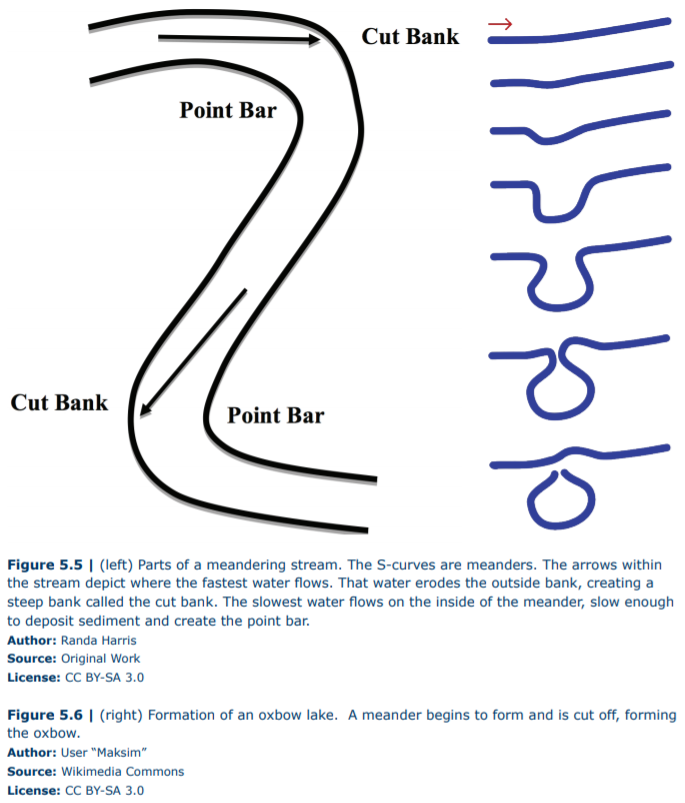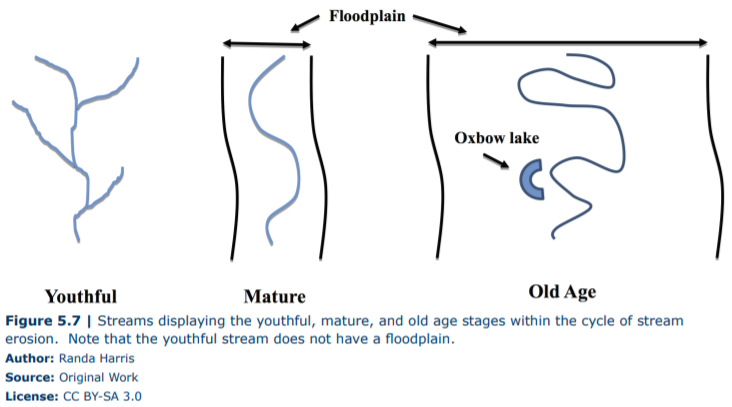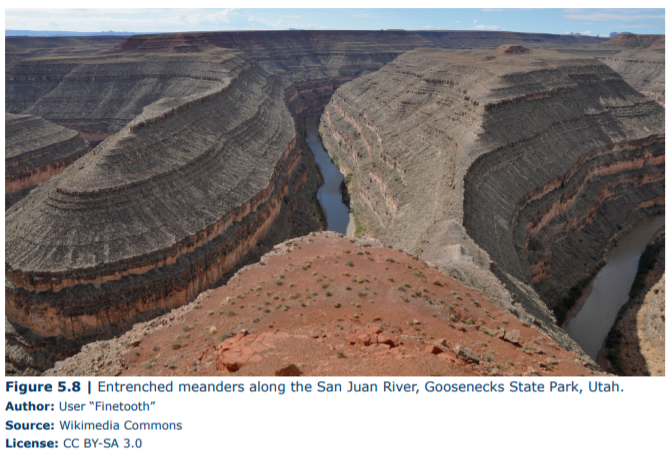Stream Starts Downcutting Again After Land Is Uplifted and the Stream Flow Increases
v.3: Stream Slope and the Cycle of Stream Erosion
- Folio ID
- 5505
Overview
Stream slope refers to the gradient of the stream's channel, or rise over run. It is the vertical drop of the stream over a horizontal distance. You lot have dealt with gradient before in Topographic Maps. It can be calculated using the following equation:
\[Gradient =\frac{(alter \;in\; elevation)}{altitude}\]
Let's calculate the gradient from A to B in Figure v.4 beneath. The elevation of the stream at A is 980', and the top of the stream at B is 920'. Utilize the scale bar to summate the altitude from A to B. \[Gradient = \frac{(980' – 920')}{two \;miles}, or\; \frac{thirty \;anxiety}{mile}\].
Stream gradients tend to be higher in a stream'south headwaters (where information technology originates) and lower at their rima oris, where they discharge into another body of water (such equally the bounding main). Discharge measures streamflow at a given fourth dimension and location and specifically is a measure out of the volume of water passing a particular point in a given period of fourth dimension. Information technology is found by multiplying the area (width multiplied by depth) of the stream channel by the velocity of the water and is frequently in units of cubic feet (or meters) per second. Discharge increases downstream in near rivers, as tributaries join the principal channel and add water.

Sediment load (the amount of sediment carried by the stream) besides changes from headwaters to mouth. At the headwaters, tributaries rapidly carry their load downstream, combining with loads from other tributaries. The main river then eventually deposits that sediment load when information technology reaches base of operations level. Sometimes in this process of conveying material downstream, the sediment load is large enough that the water is non capable of supporting it, so deposition occurs. If a stream becomes overloaded with sediment, braided streams may develop, with a network of intersecting channels that resembles braided hair. Sand and gravel bars are typical in braided streams, which are mutual in arid and semiarid regions with loftier erosion rates. Less usually seen are straight streams, in which channels remain nearly directly, naturally due to a linear zone of weakness in the underlying rock. Direct channels tin also exist man-fabricated, in an effort at flood command.
Streams may besides exist meandering, with broadly looping meanders that resemble "S"-shaped curves. The fastest water traveling in a meandering stream travels from outside bend to outside bend. This greater velocity and turbulence lead to more than erosion on the outside bend, forming a featured chosen a cutting banking company. Erosion on this depository financial institution is offset past degradation on the opposite bank of the stream, where slower moving water allows sediment to settle out. These deposits are called betoken bars.
As meanders become more than complicated, or sinuous, they may cut off a meander, discarding the meander to get a crescent-shaped oxbow lake. Check out Figure 5.6 to see the formation of an oxbow lake.

Even though streams are not living, they practise go through feature changes over fourth dimension as they alter the landscape. The ultimate goal of a stream is to achieve the base level (the low tiptop at which the stream can no longer erode its aqueduct oftentimes a lake or other stream; ultimate base of operations level is the ocean). While trying to reach this goal, the stream will feel the cycle of stream erosion, which consists of these stages:
- Youthful (early) phase – these streams are downcutting their channels (vertically eroding); literally they are picking up sediment from the bottom of their channels in an effort to decrease their elevation. The land surface volition be higher up sea level, and these streams class deep V-shaped channels.
- Mature (middle) phase – these streams experience both vertical (downcutting) and lateral (meandering) erosion. The land surface is sloped, and streams begin to form floodplains (the flat land around streams that are subject to flooding).
- Former historic period (tardily) stage – these streams focus on lateral erosion and accept very complicated meanders and oxbow lakes. The land surface is near base level.

An interruption may occur in this cycle. If a stream suddenly begins to downcut again, if bounding main level dropped (then base level dropped) or if the surface area effectually it was uplifted (retrieve building mountains), and then the stream would become rejuvenated. If the rejuvenated stream was in the erstwhile age stage, information technology will begin to grade a deep V-shaped aqueduct within that complicated meandering design that it has. This creates a bang-up geologic characteristic chosen an entrenched meander (Effigy five.8).

loveactereptur1964.blogspot.com
Source: https://geo.libretexts.org/Learning_Objects/Laboratory/Book:_Laboratory_Manual_For_Introductory_Geology_%28Deline_Harris_and_Tefend%29/05:_Water/5.03:_Stream_Gradient_and_the_Cycle_of_Stream_Erosion
0 Response to "Stream Starts Downcutting Again After Land Is Uplifted and the Stream Flow Increases"
Postar um comentário